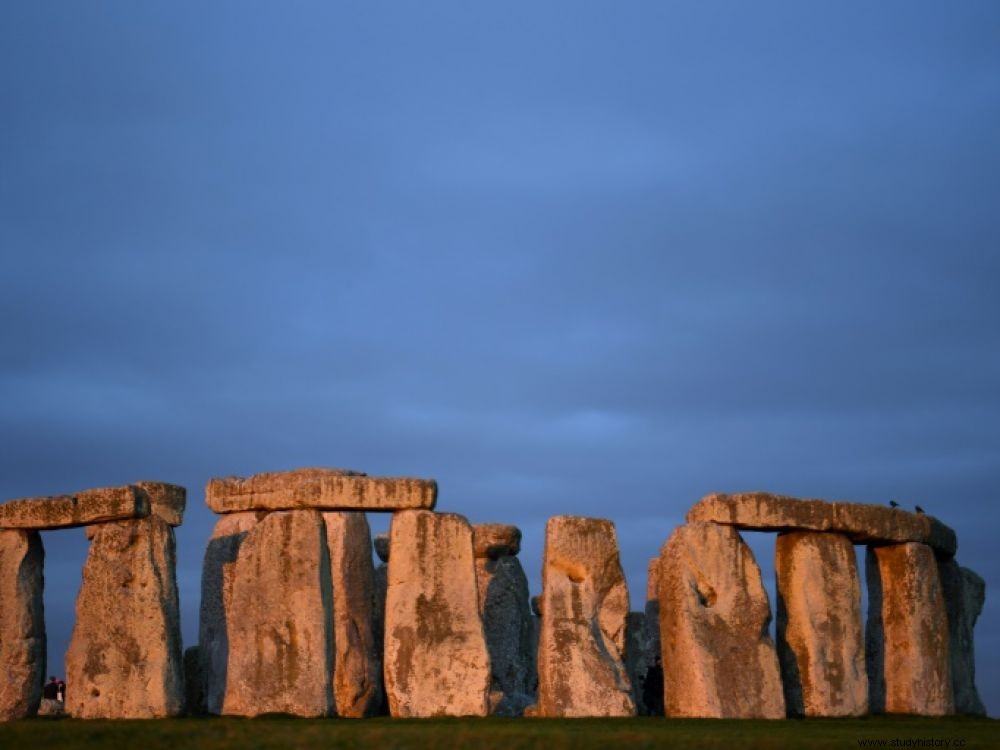On the prehistoric site of Stonehenge, in England, archaeologist Susan Greaney recounts the fates of the hundreds of people who came to build this solar temple 4,500 years ago. An "interconnected" Europe that will unveil its mysteries in an exhibition at the British Museum.

The prehistoric site of Stonehenge, near Amesbury, on January 19, 2022 in the United Kingdom
“These people were farmers, they cultivated crops, they raised animals” and “the cycle of the year must have been an integral part of their way of life” , says Mrs. Greaney as the sun rises over this vast plain, warming the icy dawn.
"Bringing new light" on Stonehenge
Stonehenge "is a temple aligned with the movements of the sun", describes this manager of English Heritage, a British organization that manages this site located 140 km west of London. This consists of the remains of two concentric circles of monoliths carved into columns and lintels at a time when metal tools did not exist. The two main gates are placed so that the sun is seen rising through one on June 21, the longest day of the year, and setting through the other on the shortest day, the December 21.
In the center could have been an altar. Adding to the mystery of this place which has fed countless legends, archaeologists have determined that many of the stones came from a site more than 250 km away. They could have been brought by the builders of this temple, as they migrated in search of more fertile land.
These stones would have been selected for their symbolic value perhaps linked to their ancestors since traces of cremation have been found, explains Neil Wilkin, curator of the exhibition "The world of Stonehenge". With this exhibition running from February 17 to July 17 at the British Museum in London, he hopes "to shed new light" about Stonehenge and dismantle the myth of primitive cavemen, highlighting that these skillful builders displayed sophisticated knowledge and practices.
"Volunteers" come from afar
A UNESCO World Heritage Site since 1986, Stonehenge was not built by slaves but by "volunteers" who traveled on a kind of spiritual pilgrimage, according to Susan Greaney. "I imagine it a bit like a trip to Mecca. Maybe once in a lifetime, you spent a year contributing to the great religious project of the community, which was to solve the problems of society , the relationship with the gods", she explains.
In 2004, 3 km away, in Durrington Walls, were found the remains of small houses, made of branches covered with plaster, where hundreds of workers were able to stay. They wore clothes made of natural fibers and leather slippers filled with grass to protect them from the cold. The exhibition seeks to establish the links of these peoples with the continent in a Europe that was then much more "interconnected" than we imagine.
First of all, "the idea of becoming a farmer came from the continent" , says Mr. Wilkin. "So we tracked that movement through the objects that moved with them." Like a green jadeite ax head extracted 1,300 km from Stonehenge, in the Italian Alps, and arrived in the region 6,000 years ago. The object is housed in the Wiltshire Museum along with other evidence of local prehistory, including a red glass bead from the Mediterranean."The exhibition will illustrate these long-distance connections" , underlines Mr. Wilkin.
"Unique opportunity"
To put Stonehenge into perspective, the British Museum will bring together 430 loaned objects from 35 collections. "This is a unique opportunity to see all these things together" , says Adrian Green, director of the museum in nearby Salisbury, which contributed to the exhibition.
This whole region of south-west England is actually dotted with Neolithic monuments, such as Woodhenge - remains of a circular structure made of logs -, West Kennet Long Barrow - five stone burial chambers - or Avebury Stone Circle - three times larger than Stonehenge, with stones weighing up to 100 tons and a 9-meter-deep moat.
The region hopes to take advantage of the media boost from the exhibition to attract visitors again. Before the pandemic, one million people visited Stonehenge every year. Because even if 100 years after its construction Stonehenge had lost its original use, the place has never ceased to fascinate. Thousands of people gather there today at every winter and summer solstice.
